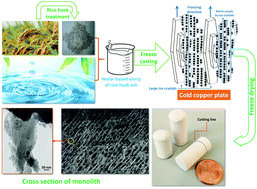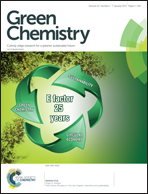Eco-fabrication of hierarchical porous silica monoliths by ice-templating of rice husk ash†
Abstract
In this study, within a sustainable chemistry approach, a clean and eco-friendly synthesis process of silica monoliths compatible with environmental limitations is developed. Rice husk (RH), a surplus agricultural byproduct, was used to engineer monoliths with a hierarchical pore structure. Amorphous and crystalline silica powders were extracted from rice husk and ice-templated using water as a liquid vehicle. The effect of silica crystallinity and silica content, as well as processing parameters such as the freezing rate and sintering temperature on the microstructural characteristics and mechanical properties of the obtained monoliths were investigated. Depending on the freezing regime, microstructural analysis confirmed the formation of macropores with lamellar or honeycomb-like structures. By varying the processing parameters, the pore size, wall thickness and porosity can be tailored. While monoliths from crystalline rice husk ash (CRHA) show higher mechanical strength, monoliths from amorphous rice husk ash (ARHA) possess a high specific surface area, demonstrating aligned nano-channels and non-uniform mesoporosity.

- This article is part of the themed collection: 2017 Green Chemistry Hot Articles

 Please wait while we load your content...
Please wait while we load your content...